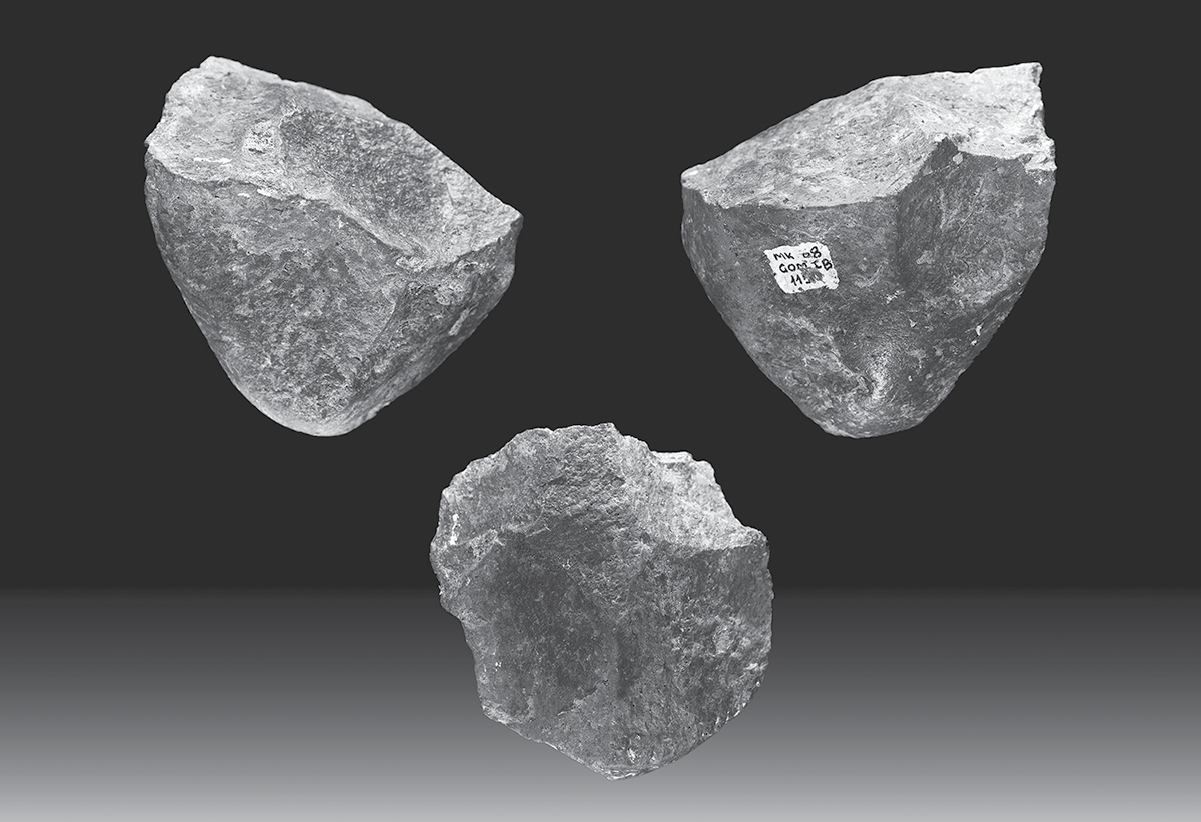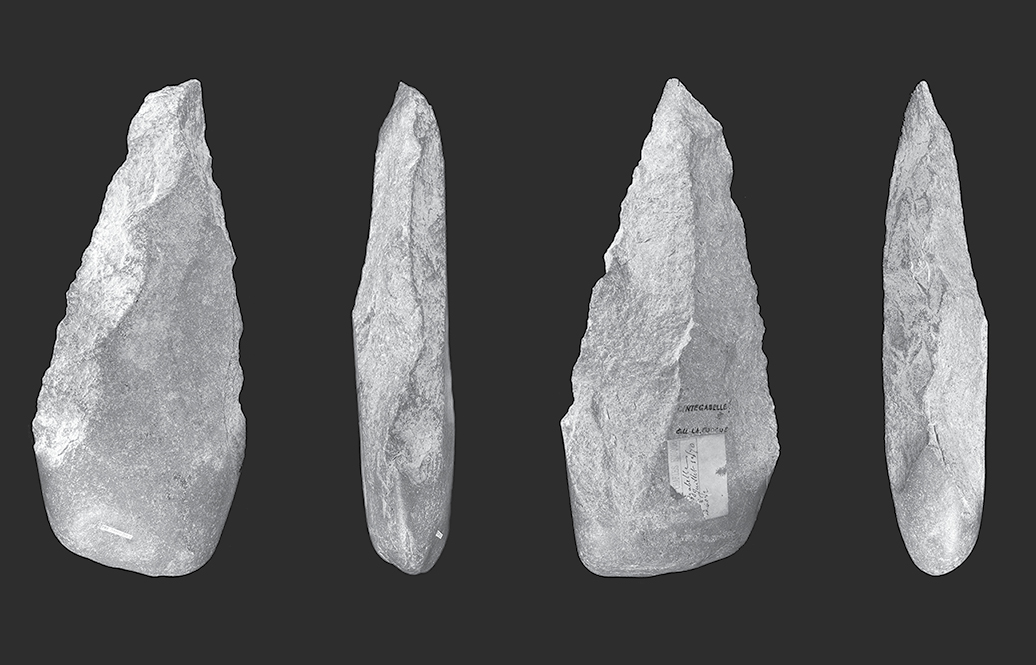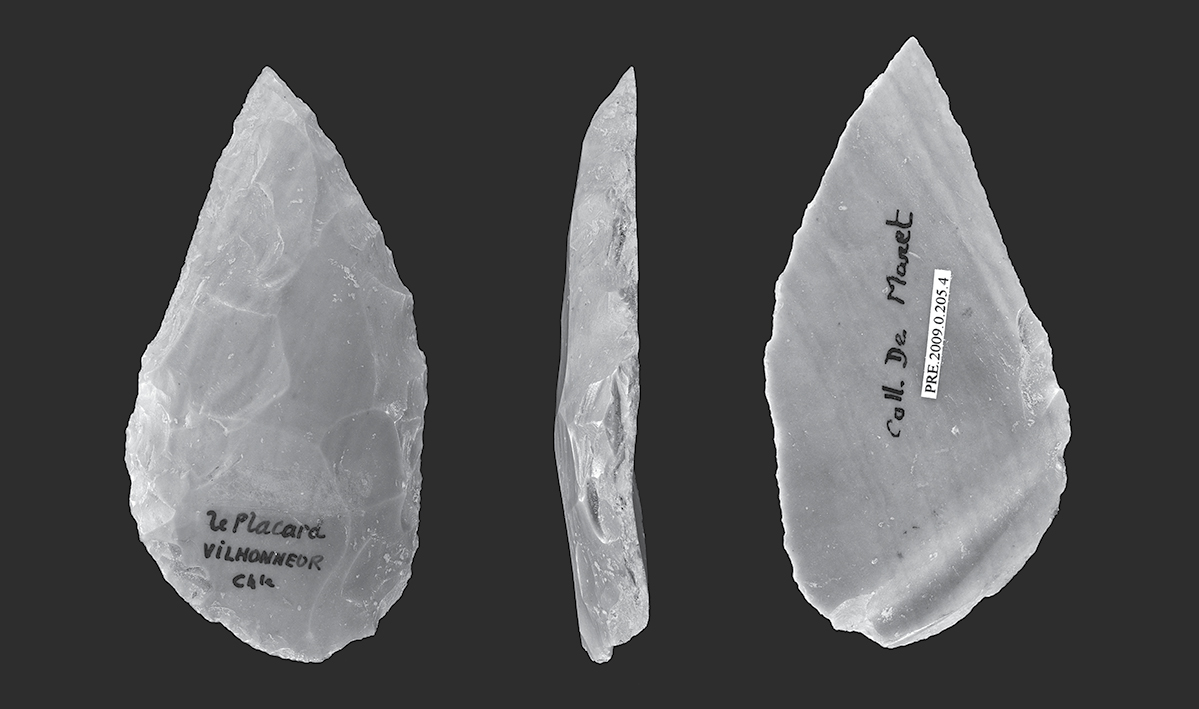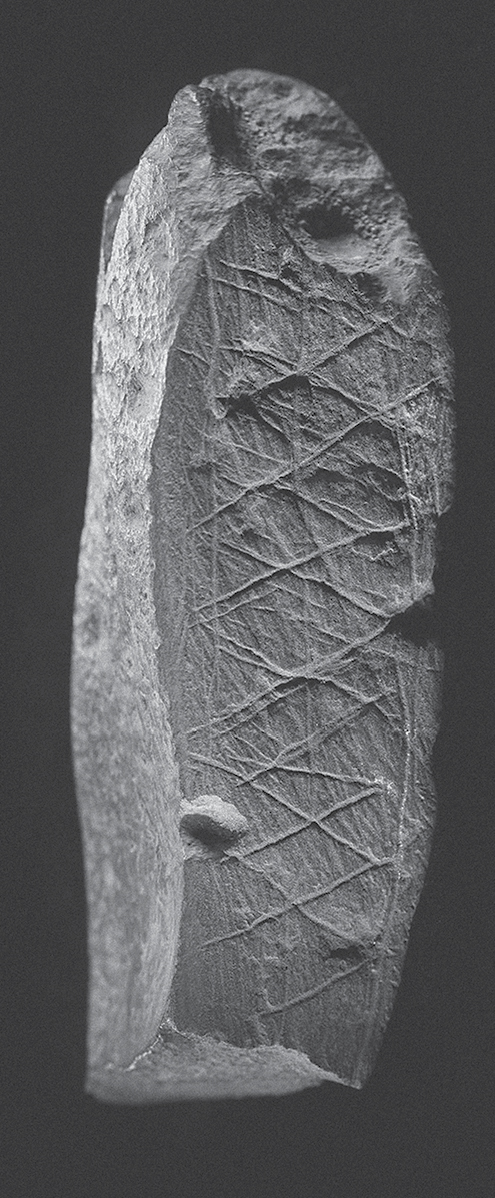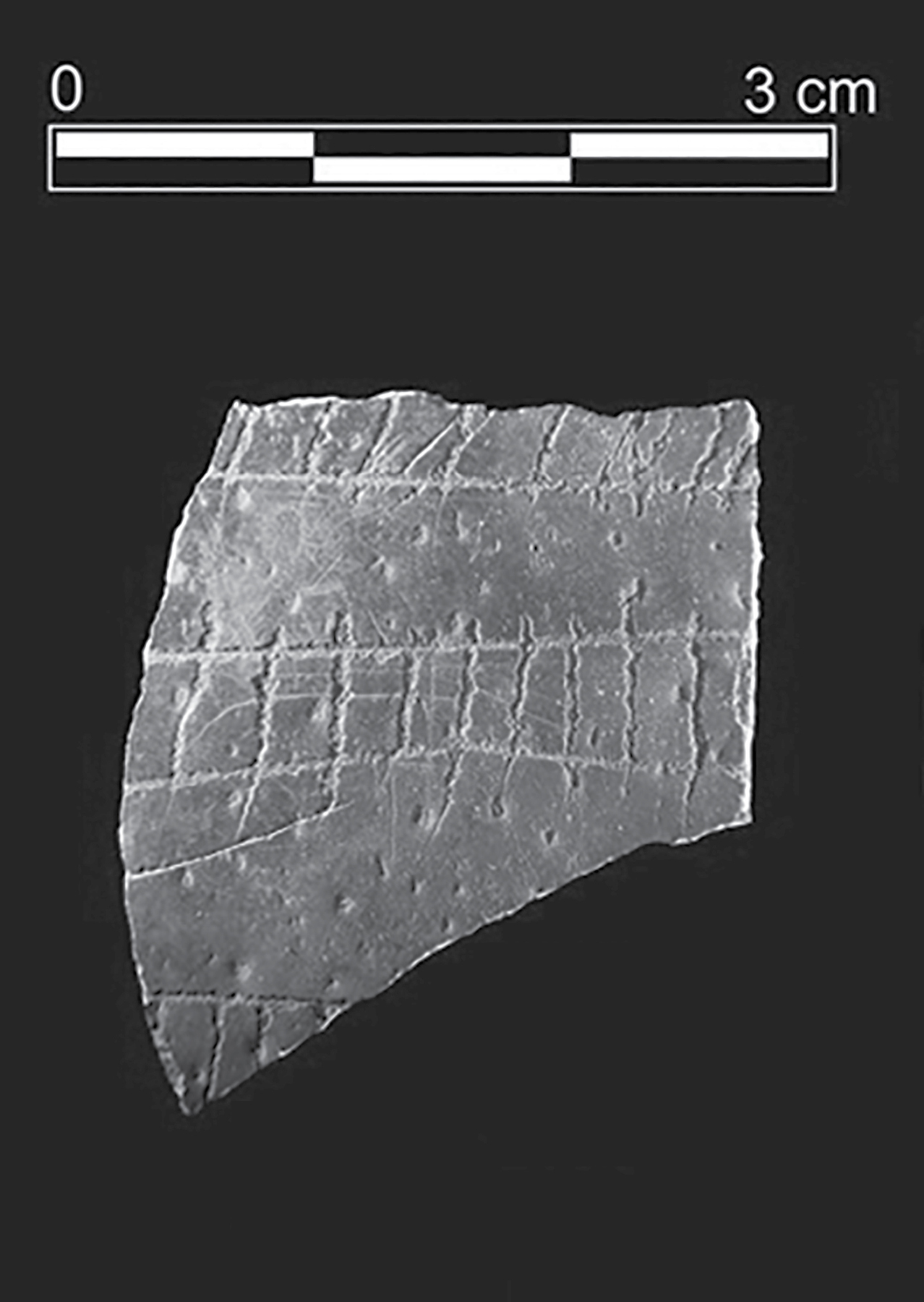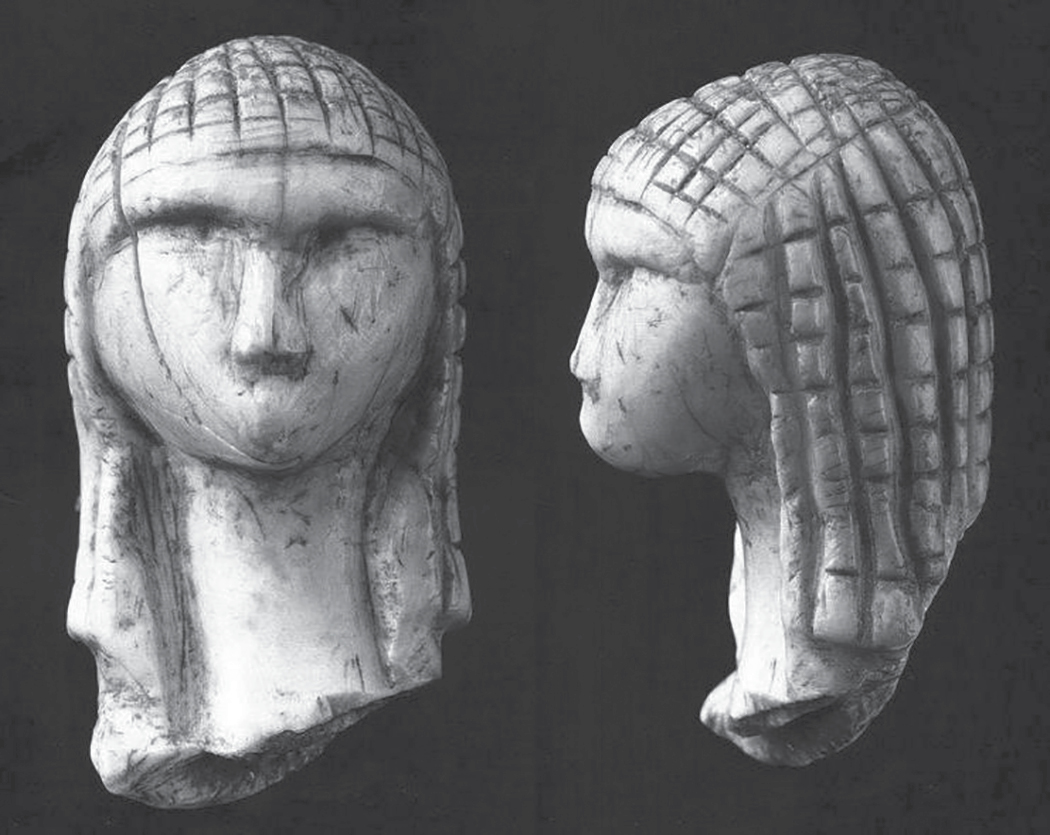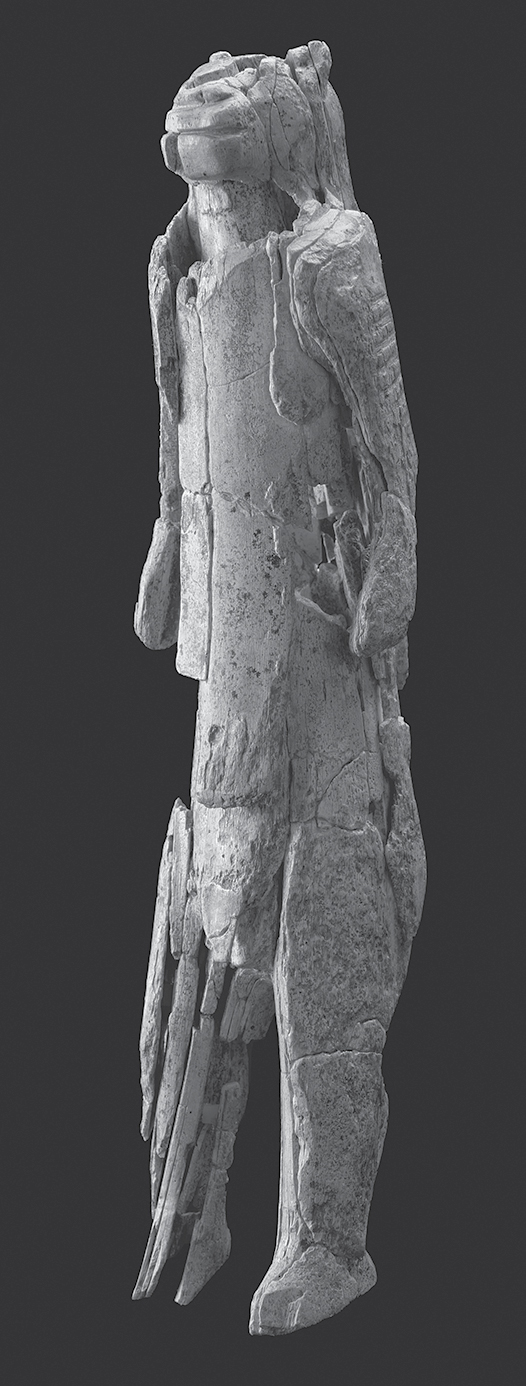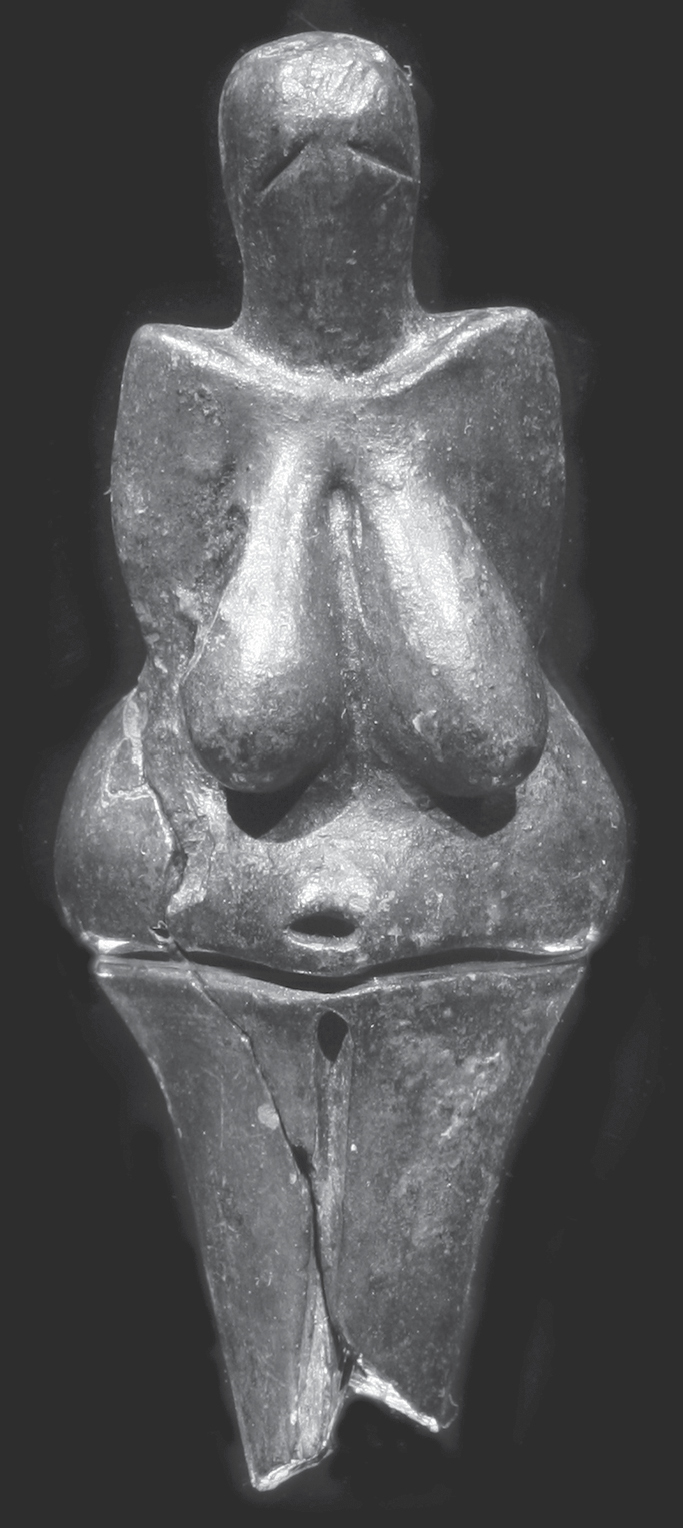Chapter 5
A Revolution in the Brain
The first stone tools appeared 3.3 million years ago, but for much of the time since then, while there were many species of Homo, and their tools showed some changes in complexity, there was in my view no real evidence of a capacity for generative invention.
Let’s just pick out three among the ancient species of Homo, who spanned the last two million years: Homo habilis, Homo erectus, and Homo neanderthalensis. They could all make simple stone hand hammers and axes to smash, cut, and scrape. But did they invent? When we look at their tools, it gives us pause, because these were simple tools. Simple because all you have to do to make one is take a piece of rock and chip at it with another rock. And although, as we’ll see, there were small changes in these simple stone tools across these three ancestors, for this long two-million-year period there was no really big change in the complexity of these tools. Their creators showed no sign of possessing a Systemizing Mechanism.
I’m going to argue that none of these hominids could invent, if we define inventing as being able to come up with a novel tool more than once. I use this strict definition (I call it generative invention) because a new tool that an animal comes up with could have arisen as a result of chance (e.g., smashing a nut with a rock), plus “associative learning,” the animal then repeating the action sequence because it leads to a reward (e.g., getting the juicy insides of the nut).1 Associative learning requires a level of intelligence and is widespread in the animal kingdom, but I argue that it’s not the same as generative invention.
Let’s look at these three ancestors in more detail.
Homo habilis lived in sub-Saharan Africa between 2.1 million years ago and 1.5 million years ago. They produced Oldowan tools, so named because they were first discovered in the Olduvai Gorge in Tanzania. Homo habilis were shorter than modern humans, with a brain less than half the size of ours. (Our cranial capacity is 1,496.5 cm3, whereas theirs was just 610.3 cm3). But by and large, they kept on making the same tool, over and over again, showing no evidence of a capacity for invention.2 And these were just very simple tools with not much more than three functions: smash, cut, and scrape.
By contrast, Homo erectus, who lived between 2.1 million years ago and 250,000 years ago, had a bigger brain than Homo habilis (with a cranial capacity of 1,092.9 cm3) and was impressive for several reasons. For one thing, these hominids were the first of our ancestors to leave Africa, spreading into Europe and Asia. And they are called erectus, for “upright man,” because they pretty much gave up an arboreal (tree-dwelling) life, became almost completely terrestrial, and, most importantly, were bipedal. Historian Yuval Harari argues that their hands became more innervated as they developed greater fine motor control. Being upright allowed them to use their hands for other purposes, so they could not only make tools but carry their stone tools with them. And they made a new stone hand ax, known as an Acheulian tool (so named because it was first found in Saint-Acheul, north of where Paris is today).3 But was this evidence that Homo erectus could invent?
Some people argue that they could because, whereas Homo habilis’s tools were made by hitting a stone with a second stone as a hammer, Homo erectus’s stone tools were made by hitting a stone with different “hammers”: a bone, an antler, or a piece of wood. These new hammers allowed for greater precision when making a stone ax. But I would challenge the view that this constituted an invention because, in my definition of the capacity for generative invention, there has to be evidence that an animal can come up with something new repeatedly, more than just once. Homo erectus niche was using tools to get marrow out of a bone, just as a woodpecker gets sap from a tree. One might argue that their new tools were inventions because they were using these tools for a new function, but a more parsimonious interpretation is that the same clear reward drove their tool-making behavior, namely, getting a food source out of an object with hard casing. Lots of animals can do that, and creating a one-off novelty is insufficient to count as generative invention, as it can arise by chance plus associative learning.
Finally, take Homo neanderthalensis (just called Neanderthals by most people). They lived between 300,000 years ago and 40,000 years ago.4 They got their name from the Neanderthal region of Germany, where they were first found. Their cranial capacity was 1,500 cm3, slightly larger than our 1,496.5 cm3, and they had large brow ridges and a slightly protruding face and chin. Neanderthals used Mousterian stone tools (so named because they were found in Le Moustier, in the Dordogne in France). Their tools were sharper and finer than those of their predecessors, but rather than being an indication of a generative capacity to invent, this may simply reflect their greater strength in being able to grip them. Some argue that they used more complex tools because they may have used fire and made hearths, both good points that we will return to. Neanderthals’ tools have been found in the Greek islands, prompting some people to speculate that they were able to invent boats, but a more cautious explanation is that they simply swam to the Greek islands. Some speculate that Neanderthals could produce birch tar as an adhesive, or produced intentional burials, but this evidence is challenged.5 So again, there is no clear evidence that they could invent.
In sum, my view is that our hominid ancestors were not inventing, if we employ a strict definition that an animal’s capacity for invention should be generative, stemming from a single drive to experiment, with anything. With a generative capacity, an animal does not just make the same simple stone hammer or ax but is able to come up with hundreds of new designs. In our hominid ancestors, we just don’t see this generativity. Genuine invention should be like genuine language: once you can produce one sentence, you can produce hundreds of novel sentences. We would be reluctant to say that a parrot has genuine language if it can only echo the same phrase over and over again. In the same way, we should not assume that simply using the same tool over and over again, with no new design features, stems from a genuine capacity for invention.
I don’t want to belittle what our hominid ancestors were doing, because using a simple stone tool to smash, cut, or scrape is still evidence of the capacity to learn. Our hominid ancestors had learned that using the tool brought rewards, and this alone can explain why they kept making tools. But the capacity to learn is not the same as the capacity for generative experimentation or invention. And many species of animal are capable of learning even if they don’t invent.
But then it all changed.

Roughly 200,000 years ago, Homo sapiens evolved in East Africa.6 Archaeologists such as Christopher Henshilwood argue that between 70,000 to 100,000 years ago humans went through a revolution in their tool-making and in our way of thinking: they started to experiment and invent, and to do so generatively. So what do we see in the archaeological record that gives a clue that a big change had occurred?
First, in South Africa, there is evidence of engraving from 77,000 years ago, a clear sign that humans were producing specialized tools. Engraving a rock was not an isolated case: soon after, we see engraved ostrich eggshells that are 60,000 years old.
A second clue that generative invention had begun was the discovery of a set of what some archaeologists interpret as beads—the first necklace or jewelry.7 Dating back to about 75,000 years old, one set of shell beads was found in the Blombos Cave on the southern tip of Africa, overlooking the Indian Ocean. Again, this was not an isolated case because another set of such perforated shells dating back even earlier, to 82,000 years ago, was found in Grotte des Pigeons in Morocco, North Africa. Not all archaeologists agree that these are beads, but this interpretation is not unreasonable. The beads were made of snail shells that had been collected miles away and appear to have then been carefully drilled with holes. Let’s assume this really was a necklace.
And here’s a third clue: bow-and-arrow hunting is exclusive to Homo sapiens and dates back to 71,000 years ago in South Africa.8 We know this because of the archaeological evidence of mortal injuries inflicted by small obsidian blades that rained down on a group of hunter-gatherers near Turkana, in Kenya, at that time.9 (Obsidian is a volcanic glass so tough and sharp that, even today, modern surgeons sometimes choose scalpels made out of it.) Bone and stone arrowheads have been found in South Africa dating this far back. The bow-and-arrow likely was used both for hunting and as a deadly new weapon because of its three remarkable advantages: silence, distance, and projectile force, each vital in both hunting and killing. The inventor would have needed to experiment with the best kind of wood for the bow and for the arrow shaft, the length of the cord, and the best material for the arrowhead, to optimize distance and velocity. Again, when you analyze it, constructing a bow-and-arrow requires systemizing: “if I attach an arrow to a stretchy fiber, and release the tension in the fiber, then the arrow will fly.”

Figure 5.3. The first jewelry, from 75,000 years ago, including ten shell beads. (Facsimiles complete the necklace.)
So, from at least 70,000 years ago—and I’ve cautiously opted to push the time-window as far back as 100,000 years, as some of the examples above date back to 82,000 years and it’s very likely that more such “complex” tools or artifacts will come to light that precede these perforated shells and engravings—we can conclude that humans were no longer just making simple stone hammers, picks, and axes, as our ancestors had been doing for millions of years up until then.
What caused this revolution in tool-making? Why did humans start to invent generatively? My thesis is that the remarkable revolution that shifted humans from simple to complex tool-making 70,000 to 100,000 years ago is best explained by the idea that the Systemizing Mechanism had evolved.
Here’s why. Engraving, to me, is a clear sign of if-and-then thinking, the defining property of the Systemizing Mechanism.10 Critically, humans now showed the capacity to think: “if I take a smooth stone, and use a tool with a fine blade, then I can engrave patterns on the stone.” In a similar way, to make a necklace also required a mind capable of if-and-then thinking: “if I have a number of shells, and drill a hole into each shell, and thread a length of fiber through each hole, then I can make a necklace.” This simple chain of beads again reveals the capacity for if-and-then reasoning.
Recall my strict definition of a capacity for genuine invention: that it should depend on evidence not of a single new artifact but rather of the workings of a generative capacity, which is a defining feature of the Systemizing Mechanism. Genuine invention can be said to occur only if we see a blossoming of many new artifacts.
In case we needed more evidence of an explosion of generative invention, around the same time, Homo sapiens crossed to the Andaman Islands in the Indian Ocean 65,000 years ago, and to Australia 62,000 years ago. This is pretty good evidence that they had invented boats, since to reach Australia from the Indonesian islands involved crossing sea channels more than 100 kilometers wide.11 We also see evidence that 42,000 years ago Homo sapiens were able to catch and eat fish.12 The oldest fishing hook is dated 23,000 years ago, while evidence of deep-sea fishing, via analysis of pelagic (tuna) fish bones, is dated to 42,000 years ago. We can only imagine how both a person’s hunting success and their health would have been transformed by this invention.
So, after more than two million years of incredibly slow change in tool use, the human drive to experiment and invent suddenly started to flower in extraordinary ways. And the generative property of these human inventions is undeniable: we see deliberately adorned graves from 42,000 years ago, and hand-printing on cave walls in Indonesia created 40,000 years ago.13 These are all signs of the same unstoppable drive to invent and experiment generatively that we see in modern humans today but that was absent in all other hominids, or indeed any other animal, before 70,000 to 100,000 years ago. And we see constructed dwellings, which were not seen among our hominid ancestors: circular huts in eastern France first appeared around 30,000 years ago.14
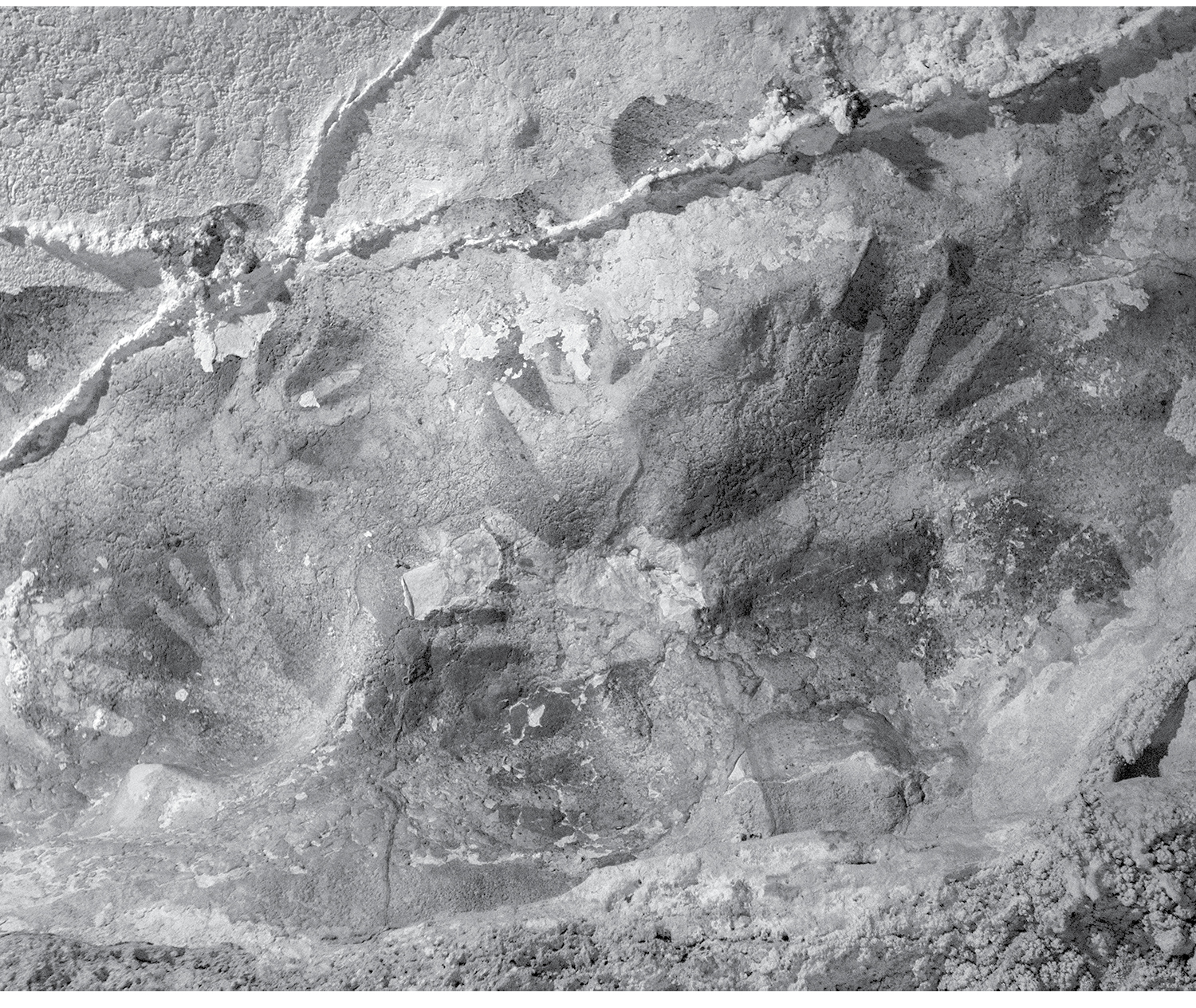
Figure 5.4. Cave art (hand-printing) from 40,000 years ago
And indeed, by 23,000 years ago, we see the emergence of another specialized tool: bone needles, presumably used to stitch animal hide to make clothes.15 It is thought that we are the only species to have ever invented a tool for making clothes. Awls (pointed tools for stitching clothing but which lack “eyes”) may date back to 61,000 years ago.
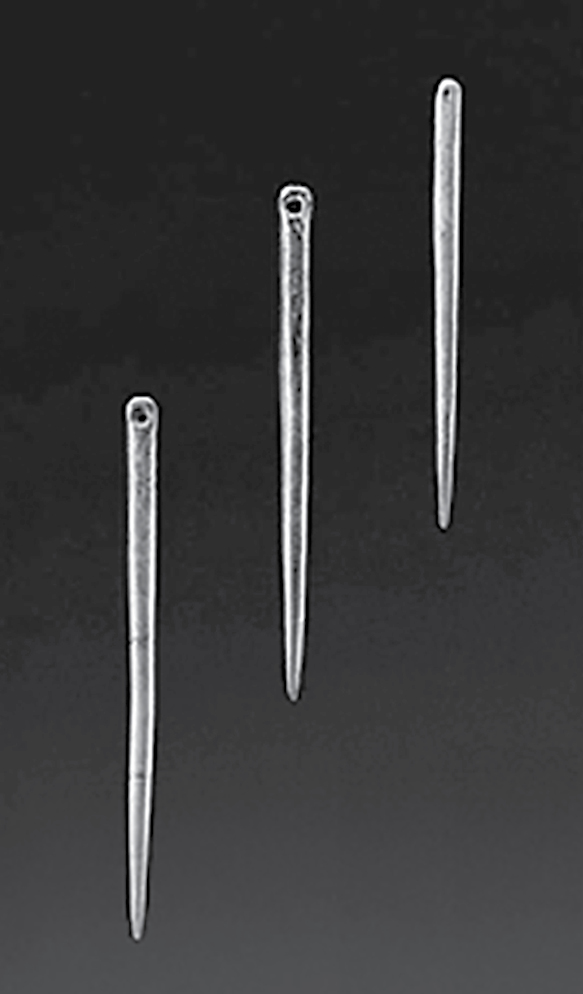
Figure 5.5. Early needles for making clothes, 23,000 to 30,000 years old, from China
Are we the only species to have shown genuine invention? Some argue that a hand-print in a cave in Spain dating from 64,000 years ago and an etching in Gibraltar dating from 34,000 years ago could be Neanderthal in origin.16 However, interpretation of these remains controversial. A conservative view is that only in Homo sapiens do we see strong evidence of genuine invention, from many novel artifacts, all of which can be unambiguously attributed to us.
Each of these new inventions by Homo sapiens was, in my argument, the expression of a mind playing with if-and-then patterns—the workings of the new Systemizing Mechanism. Consider how cave painting entails various types of if-and-then reasoning: the invention of a way to make marks on the wall (“if I have some yellow ochre, and make a mark on the wall with it, then a yellow mark stays on the wall”), followed by experimenting with making marks on walls in a systematic way (“if I make marks on the wall, and do them in this particular order, then the marks have the shape of a bison”). And we see the same experimenting with patterns in Germany 35,000 years ago, when humans were carving sculptures: an extraordinary ivory figure of a “lion-man” and a “Venus figure” of a woman with exaggerated sexual features.17
At the most basic level, inventing a sculpture like the lion-man involved reasoning along the lines of: “if I take the shape of the top half of a lion, and combine it with the shape of the bottom half of a human, then I can make a lion-man (sculpture, drawing, word, image in my mind).” Of course, there’s a lot more than systemizing involved here, and we’ll come back to this in chapter 7, particularly the idea of being able to imagine, and to imagine fictional entities. Alongside having the idea of making a sculpture or painting, one has to be able to make the tool that will be needed to carve the sculpture or paint the painting. Complex, specialized tools. I argue that the Systemizing Mechanism was a prerequisite to be able to invent.18
Indeed, to me, the most compelling evidence that a cognitive revolution occurred in the human brain is the sudden change in the rate of invention in the time line of tool production, from almost flatlining for 2.6 million years to reaching a tipping point between 70,000 and 100,000 years ago.19
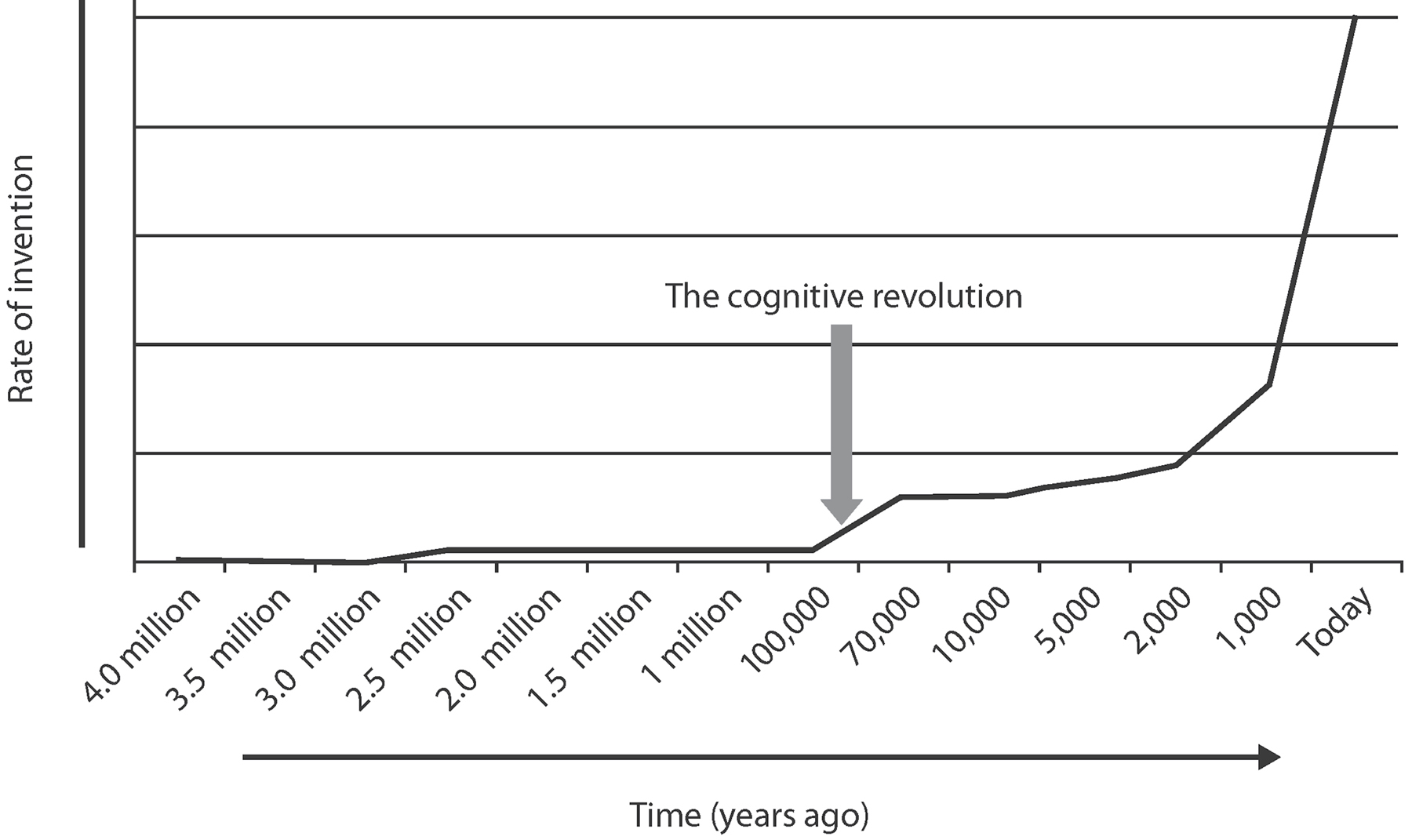
Figure 5.7. The cognitive revolution in tool-making
Yuval Harari also pinpoints the date of the cognitive revolution to 70,000 years ago. I am adopting a slightly more generous view that the cognitive revolution dates as far back as between 70,000 and 100,000 years ago, because my reading of the archaeological evidence is that the cognitive revolution occurred gradually over this period, and we can anticipate that new archaeological discoveries of complex tools will emerge in this time window. Archaeologist Richard Klein argues for a genetic mutation 40,000 to 50,000 years ago that caused an abrupt change in human cognition and behavior.20 I would agree with this choice of the date because, from then on, the evidence for invention is much clearer. But it is unlikely that a single genetic change can explain the evolution of the Systemizing Mechanism. Some big genetic changes may have contributed to the evolution of the Systemizing Mechanism, but much more likely is that hundreds if not thousands of common genetic variants contributed to its evolution. We’ll look at the genetic evidence later, but suffice it to say that polygenic traits (traits involving many genes, each having a small effect) typically evolve gradually, not abruptly.21
Taking the wider time window of around 100,000 years ago for the cognitive revolution, it is interesting to speculate on the influence of the cognitive revolution on the two major dispersals by humans out of Africa—one 108,000 years ago, when they went to the Levant and coexisted with the Neanderthals, and the other 50,000 years ago that led to humans replacing the Neanderthals by 40,000 years ago.22 Humans ended up in what today we call Australia by 40,000 years ago and in what today we call North America by 16,000 years ago. Were these dispersals out of Africa and across the world caused by the cognitive revolution as humans began to be able to invent new complex tools (like boats) and complex ways of understanding the natural world (like reading the stars) to navigate continents?
My claim is that these more complex and specialized tools were emanating from the Systemizing Mechanism. This new pattern-seeking engine in the mind used a generative algorithm that could come up with and test an infinite number of new if-and-then patterns, unleashing invention at a runaway rate. It enabled humans to reason “if I take x, and make one change to it, then x becomes y.” Humans had become pattern seekers, of a very special kind. We went from being able to make a simple stone hammer or ax to being able to invent anything. And the Systemizing Mechanism also allowed the first humans to do something else rather remarkable. We—and no other animal before or since—invented rhythm and music.

About 40,000 years ago, someone in Germany picked up a bone and turned it into a flute—to date, the oldest musical instrument in the history of the world. The Systemizing Mechanism was responsible for making the bone flute (a tool for making music), for making the tool to make the bone flute, and for making music itself (a tool for experimenting with sounds).23 All of these are complex tools, each a system characterized by if-and-then patterns. Music is, at one level, nothing more than a sequence of (rhythmic and tonal) patterns that we can intentionally vary, using if-and-then rules, although as we all know, its effects can be extraordinarily emotional. But prior to being able to have the emotional experience, we first need to be able to recognize music as patterns.

Figure 5.8. The 40,000-year-old bone flute
To me the bone flute is a beautifully clear illustration of the Systemizing Mechanism in action. The person who, 40,000 years ago, picked up this hollow bone with a hole in the side may have asked themselves a question: “What sounds can I make with this?” As they blew into one end and then placed a fingertip over the hole to cover it, they heard how the sound changed. One action (covering the hole) seemed to make a new sound, and another action (uncovering the hole) seemed to make the original sound. So this person hypothesized an if-and-then pattern: “if I make a hole in the bone, and I cover the hole with my finger and blow, then I make a different sound.” And they tested to see if this if-and-then pattern held true by repeating it over and over again.
Then the maker of the first bone flute made a second hole in the bone and repeated the whole systemizing process, listening to what happened when they blew and covered one or both holes separately or together. And then they must have done this on another hollow bone, and then on another, to experiment with another if-and-then pattern, varying the distance between the holes, until they found the combination that sounded most appealing.
When I read about the bone flute, I immediately emailed archaeologist Nicholas Conard, director of the beautiful little museum in which it is kept in Blaubeuren in Germany, to ask him if I could come visit to have a closer look at it. To my excitement, he emailed me back almost immediately, suggesting we first meet at the Hohle Fels cave, so I could see exactly where the bone flute had been found and where our ancestors had lived.

Figure 5.9. Inventing a musical instrument using the Systemizing Mechanism
I flew to Stuttgart and took a taxi deep into the countryside to Hohle Fels. As I went inside the dark cave, it felt like entering a time machine, going back to witness the origins of art and music. From the cave mouth, I descended a ladder to the deepest level of the cave. There was Nicholas, who shook my hand and welcomed me warmly. He pointed up to one stratum of the rocks and said:
“Right here is twenty thousand years ago.”
Then he pointed about a meter lower, to the next stratum in the rocks, at ground level, and said:
“Here, we are at forty thousand years ago.”
I felt a shiver of excitement. I looked down at my feet, in my modern leather shoes, suddenly aware that I was standing exactly where early humans had stood, sat, slept, and eaten 40,000 years ago. I tuned back into the present: Nicholas was showing me how he and his team were painstakingly combing through thousands of fine stones, in search of what might be tiny fragments of bone or other durable materials that could have been transformed into a human artifact or tool.
Then we drove to the museum. The bone flute is as thin and as small as your baby finger, made from the hollow wing bone of a griffin vulture. I looked at the holes along the bone flute and again had that powerful feeling of connection with the past: its maker had put his or her fingers on these holes. Nicholas played me a recording of the bone flute, performed by a modern musician, and I realized that its maker had a musical ear similar to ours today: he or she had drilled five holes into the piece of bone, spaced apart in a pattern, such that the flute would play a pentatonic scale.24 A pentatonic scale has five notes per octave; developed in many ancient civilizations, it is the basis of many musical genres, including the blues and jazz that many of us still enjoy listening to 1,600 generations later.25
From the museum I sent a text message to my son in Cambridge to communicate my excitement, and almost immediately he texted back. I reflected on how the same Systemizing Mechanism that enabled the invention of the bone flute was also responsible for inventing a text message.
And I reflected on how we are the only species that produces and responds to music, narrowly defined as rhythmic, harmonic, and melodic sound patterns that are intentionally varied in a systematic way.26 Music is able to have a deep emotional effect on our brain because we use a Systemizing Mechanism to recognize that someone else is intentionally varying these if-and-then patterns (if we’re the listener) or to produce them ourselves (if we’re the musician), to influence our emotions. Studies involving fMRI scans of the brain confirm that we find listening to music pleasurable, in that the ventral striatum, part of the reward circuit of the brain, is activated when we listen to it. We need the Empathy Circuit to intentionally influence another person’s emotional state through music or to imagine the emotional communicative intention of the composer, but we need the Systemizing Mechanism to recognize and produce the if-and-then musical patterns.
Many animal species call to each other, and some of these calls can be described as song because they have melody. Perhaps the best studied is birdsong. There’s no question that birdsong has an emotional impact on the bird-listener.27
For example, if you put a female sparrow into an audio-booth and play a recording of a male sparrow’s mating call to her, there are elevated expression levels of a gene called Egr-1 in the reward pathways of her brain. Egr-1 expression levels in these reward pathways are also elevated when an animal is given a different kind of reward: cocaine. Remarkably, if just before hearing the song the female sparrow is given a little capsule containing either estradiol (an estrogen) or placebo, to mimic her hormone levels in the mating season, she expresses even more of the genes in the reward pathways of her brain when she hears the male sparrow’s song. So, for a female sparrow, we can infer that hearing the male mating song is pleasurable.
In contrast, if you put a male sparrow in the audio-booth and play the same recording of a male sparrow’s mating call to him, the same gene expression profile is not seen in the reward pathways of his brain. Instead, he shows it in the amygdala, a brain region associated with detection of threat. If the male sparrow is given a testosterone capsule just before hearing the male song, so that his hormone levels are equivalent to those in a typical male during the mating season, this brain response to hearing male birdsong is intensified. (And this is not seen to the same degree when he’s given a placebo.) For him, we can infer that the male mating song is not pleasurable but rather is a warning signal that another male is challenging his territory.
So, in another species, song can affect the listener’s brain positively or negatively. But that’s a far cry from saying that birds or any other animals identify such sounds as music.28 Recall my definition of music: intentional, systematic variation of notes or the beat to explore if-and-then sound patterns. If new, this is generative invention of sound patterns. In contrast, most birds just produce the same melodic sequence, without much variation. Primatologist Valerie Dufour reviewed the evidence for whether, when chimpanzees drum by beating their hands against tree roots or against their bodies, this counts as music.29 She concluded that it lacks isochrony (or evenness), a key feature of music. And there’s no evidence of it being intentional systematic variation of the beat, to explore if-and-then sound patterns. The conclusion from the study of other animals is that they just don’t get the beat in music.
In contrast to what is observed in other animals, young human children are magnetically drawn to music. Give a toddler a drum or a keyboard, and he or she will imitate or generate a musical sequence, and then vary the sequence.30 In the absence of a drum, you can just clap a rhythm, and a toddler will pick up the rule and try to clap it back or vary it. Young children are listening out for if-and-then sound patterns, but there is no evidence that apes or monkeys are.31 One study found that dogs in kennels show reduced stress behaviors in response to music, but this doesn’t prove that they get the beat or recognize other musical patterns.32 And although canines (dogs and wolves) may howl together, it is unclear that they are actually trying to produce music. Other animals don’t respond to human music as music, narrowly defined.
But back to our hominid ancestors: there is no solid evidence that Neanderthals or any of our other hominid ancestors made music either.33 According to archaeologist Steve Mithen, Neanderthals did not produce a musical instrument. Interestingly, this was challenged in 1996 when archaeologist Ivan Turk announced that he had found an instrument in a cave in Slovenia. It was a bear’s thigh bone, pierced by two circular holes, and Turk said it was a flute. But subsequent evidence cast doubt on this in several ways. First, another archaeologist, Francesco D’Errico, found more bones in the same cave in which almost identical holes had been chewed by carnivores, and tooth marks opposite the holes suggested that the bones had been gripped by jaws. So the perforated thigh bone was not the result of a Neanderthal deliberately making holes to turn the bone into a flute for the intentional variation of sound patterns. Most damning of all, the ends of the bones were still blocked by bone tissue. That meant that they could never have been used as musical instruments—no one had been blowing down the hollow bone. In short, the current evidence from our hominid ancestors suggests that music, and the Systemizing Mechanism that enabled it, is unique to humans.34

About 43,000 years ago, another human picked up a baboon bone in the Lebombo Mountains between South Africa and
Swaziland and invented something else quite extraordinary: a tool for counting.35 Over time he or she made twenty-nine marks (or notches) along the bone, and archaeologists speculate that these might have been produced for some kind of ritual or, most likely, were a form of tally: a way of counting. Counting, and mathematics more generally, requires if-and-then thinking. Consider, for example: “if I take a smooth bone, and make a mark on it each morning, then the bone can show me how many days since the last full moon.” (We can easily imagine other early uses of counting, such as keeping a tally of how many items had been traded.)
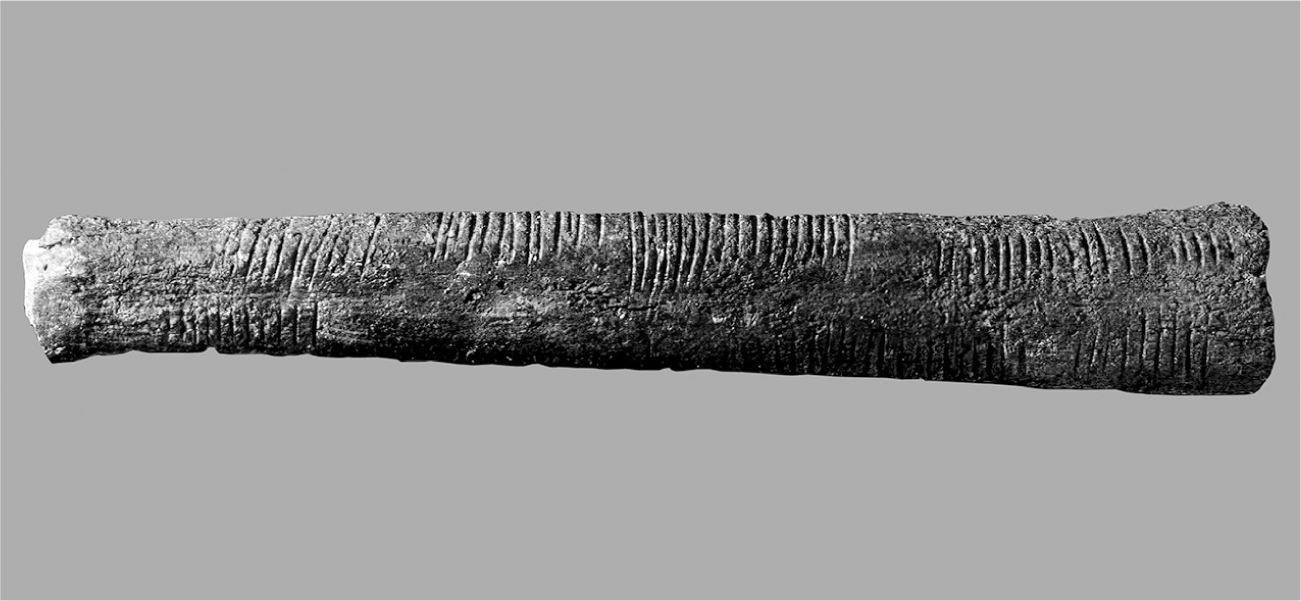
Figure 5.10. The Lebombo bone with twenty-nine tally marks on it, from 43,000 years ago. Thought to be the earliest counting device.
The Systemizing Mechanism was not just spotting if-and-then patterns in music or numbers. Its power was that it could be applied to an infinite number of objects, events, or sets of information, systemizing them, making the mechanism generative and therefore very useful. Humans could now build on or modify previous tools they had created, enabling them to run new iterations of modifications. Consider: “if I take this tool, and change this one variable, then I can produce a new version of the tool.” This alone would have led to runaway invention. This transformative new form of pattern-seeking, a new algorithm in the human mind, set us apart from every other animal, and inventing became unstoppable.
For example, by 12,000 years ago, agriculture was invented and would unfold over time. Agriculture could provide food in large quantities because we could now see plants and animals themselves as complex tools or systems that could do the work to feed humans. The story of agriculture—or the domestication of plants and animals—is extraordinary. It was invented independently in multiple locations: it started in southeastern Turkey, the western Levant, and the Levant, and then appeared in China, Central America, and South America. Growing wheat 9,000 years ago meant for the first time we could make bread, and new foods were produced at scale. Soon we were growing peas, barley, and lentils (8,000 years ago); olive trees (5,000 years ago); grapes, cashew nuts, rice, maize, corn, potatoes, and millet (3,500 years ago). We were also domesticating horses, camels, sheep, and goats by this time.36
And it is clear that agriculture needed the Systemizing Mechanism.37 Consider these examples, where one could use one or more of ands in the if-and-then pattern: “if I sow my wheat seeds, and I use a hoe to plant them more deeply, [and I weed the field, and I guard my fields against parasites, and I water my field every day, and I scatter dung on them], then I will get a better crop.” (As you can see, you can keep adding as many and variables in the if-and-then pattern as you wish.) And agriculture was not just about gaining control over plants but also over animals. Consider: “if I take my ox, and castrate him, then he will be more obedient.” Or consider: “if I take my male chicken, and castrate him, then the meat quality will be better.” In short, agriculture was a sign that humans had systemized nature, harnessing it under their control.38

Systemizing continued to be an unstoppable force for generative invention. Consider just four examples of transformational systems developed by humans between 5,500 and 4,000 years ago:
First, the wheel: “if I take a piece of wood, and cut it in a circular shape, then it will rotate.”39 The earliest example of a wheel was found in Mesopotamia in the late Neolithic era. Starting about 11,000 years ago and lasting until about 5,500 years ago, the Neolithic era (or New Stone Age) was remarkable because it marked the transition from a hunter-gatherer lifestyle to agricultural settlement and early civilization. The wheel played a vital part in all of this. Think of the many applications of the wheel, all of which are tools that do work for us: the ship’s wheel (to steer a vehicle), the potter’s wheel (to create a clay pot), the flywheel (to cast a fishing hook), and the cogwheel (to drive another wheel), among many variations.
The second transformational system was writing, invented 5,500 years ago in Sumeria in the Euphrates Valley.40 Writing on clay tablets was first used for counting (to keep track of who had paid tax or who had an IOU against produce). But by 3,000 years ago, cuneiform or Egyptian hieroglyphics was a “full script,” meaning that they could be used to convey anything. Once again, we can see the if-and-then algorithm at work: “if I start with a clean surface, and make marks on the surface, then these marks can stand for objects or ideas.” Of course, this algorithm presupposes a capacity for reflecting on and representing ideas, for which the Empathy Circuit was needed. But the mechanical act of writing also required the Systemizing Mechanism. Writing is so important that it defines the separation between prehistory and history.
Third was mathematics, again invented 5,000 years ago.41 Mathematics of course covers not just arithmetic but all its related remarkable branches and applications: from algebra, geometry, and astronomy to engineering, taxation, and recording time. Consider: “if I take the number 3, and cube it, then the number becomes 27.”
And finally: religion.42 We know that Hinduism, for example, is at least 4,000 years old. It included an elaborate system of rules governing the caste system, in which there were if-and-then laws of purity and pollution, and distinctions were made between groups of people: the Brahmins (the priest caste) and the Shudras (the servants) were just a few of the 3,000 castes, defined in contrast to the “outcastes” or Untouchables. While the Empathy Circuit would have been needed to imagine a god with a mind, with thoughts and feelings, the Systemizing Mechanism was needed to create a system of if-and-then laws.
By 4,000 years ago, cataloging had been invented in many places (Sumeria, Egypt, ancient China, and the Inca empire in South America) so that written information could be archived and retrieved. By 3,700 years ago, the new Systemizing Mechanism allowed us to forge new materials, like bronze.43 By 1776 BC, King Hammurabi of the first Babylonian dynasty had written a legal code that included rulings formulated using the if-and-then format. For example: “if a superior man strikes a woman of superior class, and that woman should die, then they shall kill his daughter.” 44
So systemizing was leading not just to mechanical inventions but to inventions of any system, including legal systems that prescribed a moral code and defined justice.45

Let’s go back to a fact that challenges the Systemizing Mechanism theory: Homo erectus used fire, long before the cognitive revolution, at least 400,000 years ago, and on some accounts on a daily basis by 300,000 years ago. Neanderthals used fire too. Surely, some would argue, that’s a sign of the capacity for invention and experimentation? If Homo erectus was using fire that long ago, doesn’t this disprove the theory that the capacity for invention only evolved 70,000 to 100,000 years ago with the Systemizing Mechanism?46
It was undoubtedly a huge step forward when our ancestors first controlled fire. The domestication of fire had so many remarkable advantages. First, it enabled our ancestors to eat foods that would otherwise have been inedible (think of rice or potatoes), so they developed a more varied diet. In addition, cooking made meat more tender, enabling it to be eaten more quickly (in minutes, whereas chewing raw meat can take many hours).47 And eating cooked food is thought to have led to a reduction in human gut size, freeing up energy for growing a larger brain. Fire also enabled our ancestors to stay healthy by eating foods that were free of infectious bacteria and parasites (since these are destroyed by heat during cooking). Fire also allowed our ancestors to clear forests to attract game to graze, which was an easier way to get lunch. The first barbecues would have been our ancestors’ cooking what they caught. Aside from cooking, fire most obviously provided our ancestors with light, enabling them to live in caves and see in the dark, as well as to scare away lions and other predators. And it enabled our ancestors to stay warm in colder environments as they moved out of Africa.
Later, the domestication of fire would lead to a suite of other things, like baking clay to create ceramic objects, heat-treating stones to create stronger tools, and clearing forests for planting. But these last functions of fire would not have been relevant to Homo erectus, because there is no evidence that they engaged in any of them. So, although Homo erectus used fire, they may not have been systematically experimenting. Rather, they were likely using it just opportunistically, keeping naturally occurring fires burning, for example, after lightning strikes. In other words, using fire need not be evidence that Homo erectus invented fire production.
Controlled use of fire is more relevant to the Systemizing Mechanism, since it suggests that fire was used for a purpose, systematically, and as a tool. The earliest evidence of the controlled use of fire is from much later, about 200,000 years ago, when we see examples of building a hearth (a fireplace). These were often formed by collecting stones into a ring, perhaps to contain a fire, or perhaps to reuse the same location for a fire. This example of using fire precedes the cognitive revolution by at least 100,000 years. Although it can be argued that building a hearth would have required if-and-then reasoning, the fact that this is an isolated example means that it could have arisen, like other forms of animal “culture,” through processes like imitation. Recall that for something to count as genuine invention, it should occur more than once, in the context of other inventions, not just as a one-off piece of behavior.
In contrast, a clearer example of the controlled use of fire is the creation of earth ovens (hearths that are banked up with clay, sometimes into a dome) for cooking, heating, and, in the first kilns, hardening clay figurines. But these uses are only seen from 40,000 years ago, that is, after the cognitive revolution, and they coincide with more intentional uses of fuels (such as wood, peat, animal dung, or straw).
Therefore, while controlled use of fire is an indicator that a big cognitive change had occurred in humans, simple use of fire may not be. If we are being super-cautious and not ascribing the capacity to invent or experiment to an animal without multiple examples in support of this, then we should conclude that Homo erectus simple use of fire could have just been the result of associative learning following a one-off chance event, but not a sign of the capacity for genuine invention.

Was the fact that Homo sapiens alone could invent and experiment generatively one of the reasons why Neanderthals became extinct 40,000 years ago? Neanderthals and modern humans coexisted for more than 5,000 years, and from the archaeological record it is clear that we overlapped in time and sometimes even in space, sharing caves. We even had sex together: How else are we going to explain that 1 to 4 percent of non-Africans’ DNA is Neanderthal in origin?48 But looking at the tools Neanderthals used, one can see that these were still mostly the same limited simple tools for smashing, cutting, and scraping while modern humans were producing complex tools like bow-and-arrows and creating art, sculpture, and musical instruments. There is some speculation that Neanderthals may have used spears and possibly adhesives to attach a stone tool to a spear (so-called hafting), but the evidence, which remains incredibly sparse and open to other interpretations, has been challenged.49 Conservatively, one would have to conclude that there is no good evidence that Neanderthals could experiment and invent generatively.
Neanderthals started to die out around 40,000 years ago, when the cognitive revolution was in full swing.50 They may have died out because Homo sapiens, using our suite of smarter, more complex tools, themselves products of the Systemizing Mechanism, could acquire resources more efficiently, leaving poor Neanderthals with less. And they may have died out because Homo sapiens, using our greater social intelligence, including the capacity for deception (a product of the Empathy Circuit in our brain), could run rings around them. There’s no evidence that Neanderthals could deceive, and if this was the case, they would have been at a massive competitive disadvantage. As we mentioned earlier, there is no evidence of the stealthy use of arrows or darts by Neanderthals, unlike Homo sapiens, who lived at the same time and whose stone tips have endured. Nevertheless, the absence of evidence is not evidence of absence.
Other reasons have been postulated for why Neanderthals died out, but my contention is that the combination of the new Systemizing Mechanism, enabling complex tool-making, and the Empathy Circuit, enabling complex social interaction and deception, led Homo sapiens to become unrivaled. The absence of genuine invention in pre-humans and its presence in the human archaeological record point to the evolution of the Systemizing Mechanism.

Let’s go back to the inventor of early jewelry around 75,000 years ago: he or she may have been thinking about how they would be perceived by others (will wearing jewelry enhance my beauty or my social status?), or thinking of someone who might appreciate the necklace as a gift.51 Either motivation would have required empathy. In the same way, we can assume that a cave painter 40,000 years ago had a theory of mind, if their motivation was to communicate an idea to an imagined audience who might look at the painting at some point in the future. So, the invention of jewelry is a clue that around 75,000 years ago humans were not only capable of if-and-then thinking but also that they were self-conscious—they were thinking about how others saw them. That little string of beads is a big clue that humans 75,000 years ago were capable of self-reflection—another benefit of the Empathy Circuit.52
The Systemizing Mechanism gave rise to the capacity for invention and experimentation, while the Empathy Circuit gave rise to the capacity for thinking about another person’s thoughts and about one’s own thoughts and allowed for flexible communication. Together, these two new cognitive modules constituted the cognitive revolution. Although the Systemizing Mechanism and the Empathy Circuit are separate, as demonstrated by the fact that many autistic people struggle with theory of mind and yet can be talented at experimenting, these brain mechanisms clearly interact, as is seen in two uniquely human behaviors: language and music.53
Systemizing allows us to understand and produce syntax and the other rule-based patterns of language and to recognize and produce the melodic patterns in music. But empathy allows us to read between the lines in language, to understand a speaker’s intended meaning behind what is or is not said, or is said obliquely or figuratively; and empathy allows us to connect with others emotionally through music. In sum, empathy and theory of mind can explain why early humans experimented to make jewelry, art, sculpture, and music, but by itself it cannot explain how humans experimented to make jewelry and other forms of art. For that, we needed the Systemizing Mechanism.

Systemizing seems to have been absent in our hominid ancestors. But to really prove that the Systemizing Mechanism was part of the cognitive revolution in the human brain we need to show that systemizing is absent in other animals. To do this, we need to examine the evidence from comparative psychology.
It’s time to look at our close relatives—monkeys, apes, and other animals.
